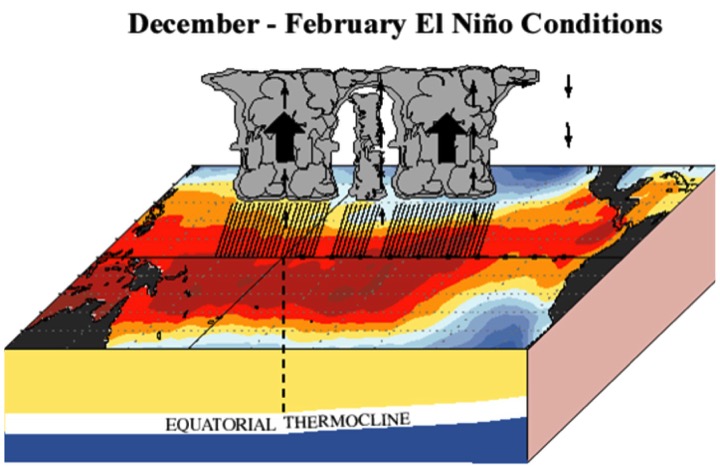El Niño and La Niña are officially defined as sustained sea surface temperature anomalies of magnitude greater than 0.5°C across the central tropical Pacific Ocean. When the condition is met for a period of less than five months, it is classified as El Niño or La Niña conditions; if the anomaly persists for five months or longer, it is classified as an El Niño or La Niña episode. Historically, it has occurred at irregular intervals of 2-7 years and has usually lasted one or two years.These periods often coincide with the transition between El Niño and La Niña events. During ENSO-neutral periods the ocean temperatures, tropical rainfall patterns, and atmospheric winds over the equatorial Pacific Ocean are near the long-term average.
El Niño
What Causes an El Niño?
During El Niño conditions, the usually present east to west winds weaken and an anomalous west to east flow develops. The west to east flow drives warm equatorial waters from the western Pacific towards the eastern Pacific and northern South America.
Impacts of El Niño in the eastern equatorial Pacific include an increase in sea level heights, a decrease in cool water upwelling and an increase in sea surface temperature. The increase in sea surface temperature leads to increased convection and an increase in the risk for heavy precipitation in northwestern South America.
During El Niño, the following conditions are likely:
- Lower Atmospheric Circulation: Towards the East (western Pacific) and towards the west, but weaker (eastern Pacific)– Surface air pressure is anomalously low over the central equatorial Pacific, for example Tahiti, and anomalously high in the western equatorial Pacific, for example Australia. This reduced gradient in surface air pressure drives a flow of surface air moving from higher pressure to lower pressure, or west to east across the western equatorial Pacific. Across the eastern Pacific, the usually strong east to west wind is suppressed.
- Surface Water Circulation: Towards the East– The lower atmospheric circulation has a direct effect on the surface water beneath it. In the western Pacific, the west to east movement of air in the lower atmosphere along the equatorial Pacific Ocean works on the water below it. During El Niño conditions, this means net surface water transport from west to east resulting in warmer than average surface water temperatures in the central and eastern Pacific.
- Upper Atmospheric Circulation: Towards the West– Low level winds converge over the anomalous warm waters of the central and eastern Pacific and rise. The forced ascent of the very moist air creates heavy rainfall in the region, wringing the air of moisture. The now dry air diverges out of the top of the convective region, moving out over the western Pacific to sink over the cooler than average waters.
- Thermocline: Decrease in slope, slanted down from the eastern Pacific to the western Pacific-The thermocline marks the transition between the warm upper water and the cold deep water in the Pacific Ocean. The decrease in slope suppresses upwelling from cold water in the eastern equatorial pacific and allows warm water from the western pacific to flow eastward towards South America.
Pacific Adventures: The Climate Change Crab ENSO Definition
This animation is an exciting new tool to raise awareness of the science and impacts of El Niño and La Niña and encourage Pacific Islanders to take early action in preparing for these extreme events.
The film stars a comical and highly resilient crab and follows her escapades across the Pacific.
The Pacific island countries can experience very wet or very dry conditions as a result of El Niño and La Niña. These conditions, along with extreme events like cyclones, can have serious impacts on water quality, food security, infrastructure (like houses and roads), livelihoods and health. However, good quality climate and weather information, warnings and forecasts can help us anticipate and prepare for changing risks.
The animation comes with a resource ‘tool kit’ to help facilitators link the information in the film with smart decision-making and action on the ground.
You can download The Pacific Adventures of the Climate Crab animation and screen it in your community or workplace.
Submitted by Peter Sinclair




